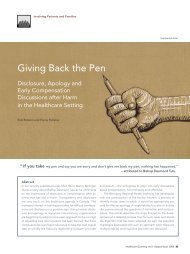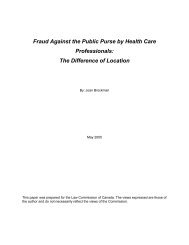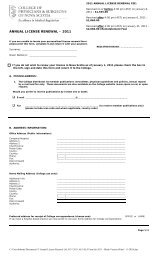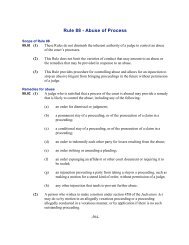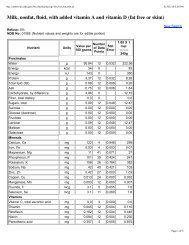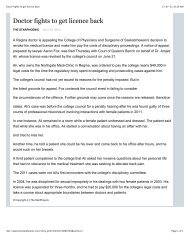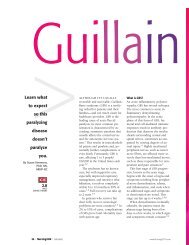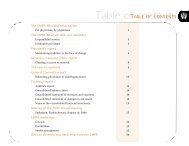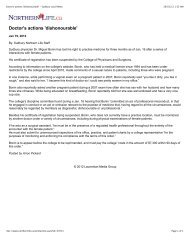Experiments That Changed Nutritional Thinking - TUUM EST
Experiments That Changed Nutritional Thinking - TUUM EST
Experiments That Changed Nutritional Thinking - TUUM EST
You also want an ePaper? Increase the reach of your titles
YUMPU automatically turns print PDFs into web optimized ePapers that Google loves.
1026S<br />
SUPPLEMENT<br />
TABLE 2<br />
the body, certainly under ordinary conditions of life’’ (p. 475,<br />
Chittenden 1904).<br />
Perhaps it ought to be noted that these experiments did<br />
not actually establish an average, minimum physiological re-<br />
quirement for dietary protein in these groups of subjects because<br />
1) the low protein diets were freely chosen by the professional<br />
group, 2) the athletes were instructed to diminish the<br />
intake of protein but without imposition of a specific diet,<br />
and 3) the soldiers were given meals that contained lowered<br />
amounts of protein than provided by ordinary army rations<br />
and apparently with some reduction in the total ‘‘fuel value’’<br />
of the food. The food given to each soldier was weighed, and<br />
at the close of every meal the uneaten food was determined<br />
and subtracted from the initial weight.<br />
Although there has been some concern about the precision<br />
and accuracy of the nitrogen balance data generated from<br />
Chittenden’s experiments (McCay 1912, Carpenter 1994), including<br />
the reliability of the urine and fecal collections and<br />
determination of nitrogen intake, the results of these series of<br />
experiments were coherent and dramatic. They presented a<br />
strong case that the physiological needs for protein were much<br />
lower than values represented by free-choice intakes of dietary<br />
protein.<br />
Chittenden’s conclusions were neither quickly nor univer-<br />
sally accepted. For example, McCay (1912) referred to the<br />
onslaught to Chittenden’s findings and ideas, but he used his<br />
own data from dietary surveys of Bengalis, as well as the data of<br />
others, to reach a conclusion that ‘‘Voit stands today absolutely<br />
vindicated.’’ Although Cathcart (1911) was in ‘‘complete<br />
agreement with Professor Chittenden’s statement that life can<br />
be maintained and frequently maintained at a high level on<br />
relatively low protein intake,’’ he was not sure if it was desir-<br />
able to keep a low intake as a general rule, and he expressed<br />
concern about the quality of protein. Later, he (Cathcart 1921)<br />
voiced reservations that were related to the lowered resistance<br />
to disease in persons consuming low protein diets. However,<br />
Chittenden (1911) had already argued that the problem with<br />
McCay’s studies was that the diets of the populations studied<br />
in India lacked unidentified trace nutrients. This was probably<br />
true, in retrospect, given the public health problems of iron,<br />
vitamin A and iodine deficiencies that are prevalent in south-<br />
east Asia today.<br />
The protein standards for healthy individuals continued<br />
to be set by the opinions of individuals until national and<br />
international committees were convened to establish dietary<br />
recommendations. An early international committee was set<br />
up by the League of Nations, and in 1936 the recommendation<br />
was that ‘‘the protein intake for all adults should not fall below<br />
1 gramme of protein per kilogramme of body weight . . .’’<br />
(League of Nations 1936). No scientific justification was presented<br />
in support of the recommendation. In 1943 the U.S.<br />
Food and Nutrition Board of the National Academy of Sci-<br />
ences issued its first Recommended Dietary Allowances, and<br />
in this report 66 g of protein daily was recommended. These<br />
early figures proposed by expert groups were somewhat higher<br />
than those found to be sufficient by Chittenden, but they were<br />
far below the liberal standards that had been widely adopted<br />
during the middle 19th and on into the early part of the<br />
20th century. It seems clear, however, that by the 1950s the<br />
metabolic approach used by Chittenden and others for establishing<br />
protein requirements had been well embraced, to the<br />
exclusion of the dietary intake approach followed by Voit,<br />
Atwater and others. For example, at the Princeton Conference<br />
in 1955, W. R. Aykroyd, the director of the nutrition division<br />
of the Food and Agriculture Organization, stated: ‘‘We need<br />
A typical day’s record of R. H. Chittenden’s diet and nitrogen<br />
balance after 18 mo on his self-imposed experiment1<br />
Sunday, June 26, 1904<br />
Diet<br />
Breakfast: Coffee 122 g, cream 31 g, sugar 8 g.<br />
Dinner: Roast lamb 50 g, baked potato 52 g, peas 64 g, biscuit<br />
82 g, butter 12 g, lettuce salad 43 g, cream cheese 21 g,<br />
toasted crackers 23 g, blanc mange 164 g.<br />
Supper: Iced tea 225 g, sugar 29 g, lettuce sandwich 51 g,<br />
strawberries 130 g, sugar 22 g, cream 40 g, sponge cake 31 g.<br />
Body weight Å 57.4 kg (initial weight in November 1902 Å 65 kg.<br />
Age 47 y)<br />
Protein intake Å 0.64 g/kg<br />
N balance Å00.07 g N<br />
Energy intake Å 1549 kcal<br />
1 Data from Chittenden (1904).<br />
Back then was no different than today, in that Chittenden<br />
needed financial support for the conduct of his investigations.<br />
He secured funds from the Carnegie Institution of Washington<br />
and the Bache Fund of the National Academy of Sciences,<br />
and he also received large donations from Fletcher and John<br />
H. Patterson of Dayton, Ohio.<br />
The overall investigation consisted of three major experi-<br />
ments, each characterized by a long-term period of dietary<br />
protein restriction combined with nitrogen excretion measure-<br />
ments and supplemented in some studies with assessments of<br />
physical and mental well-being. Chittenden (1904) states<br />
‘‘The writer, fully impressed with his responsibility in the conduct<br />
of an experiment of this kind, began with himself in<br />
November 1902.’’ He therefore served as one of the subjects<br />
in his study of five university professors and instructors, includ-<br />
ing his former student Lafayette Mendel, who by that time<br />
had become professor.<br />
On the basis of his own experience (Table 2), including the<br />
disappearance of the rheumatic problem he had been having<br />
in his knee joint and the findings with the other four Yale<br />
professionals, Chittenden concluded that the minimum ‘‘proteid’’<br />
requirement was 93–103 mg N/kg body wt (about 0.6–<br />
0.64 g proteinrkg 01 rd), which anticipates, by 80 years, the<br />
mean requirement figure of 0.6 g proteinrkg 01 rd 01 propos-<br />
ed by FAO/WHO/UNU (1985)!<br />
The next two series of studies confirmed and strengthened<br />
these initial findings; one of these was with 13 members of a<br />
detachment from the U.S. Army Hospital Corps, who were<br />
housed in Vanderbilt Square at Yale for 6 mo. The study<br />
included measures of physical and mental condition and of<br />
blood composition in addition to nitrogen excretion and bal-<br />
ance over the 6-mo period. The conclusion was that 50 g of<br />
protein daily can establish nitrogen equilibrium and that there<br />
is, at this approximate intake, a maintenance of physical<br />
strength and vigor and an ability to respond to sensory stimuli.<br />
In a follow-up letter written to Chittenden by one of the<br />
participants, Private First Class J. Steltz, and on behalf of the<br />
other men, he stated: ‘‘The men are all in first-class condition.<br />
. . . We eat very little meat now as a rule, and would willingly<br />
go on another test.’’ The extensive findings in a third series<br />
involving eight Yale University athletes merely served to repli-<br />
cate all of these data and the interpretations that had been<br />
drawn from them.<br />
Thus, Chittenden concluded that one-half of the 118 g of<br />
protein called for daily by the ordinary dietary standards is<br />
quite sufficient to meet all the real physiological needs of<br />
/ 4p09$$0062 04-07-97 14:02:12 nutras LP: J Nut May Suppl<br />
Downloaded from jn.nutrition.org by on June 3, 2010



